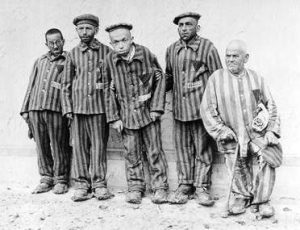
It’s 1941. A short man with a cane is led into a gas chamber. Following him is a man with spina bifida, and another in a wooden wheelchair, and many more. After the screams, the Nazis incinerate or bury their corpses in mass graves. The uniforms they were killed and buried in had a black triangle sewn to its left breast. The road to the greatest atrocity in human history had been paved decades in advance. Germany, under the Third Reich, began a forced sterilisation program for the disabled in 1933, as the Nazis believed that the disabled were a waste of valuable resources, merely more mouths to feed that it could not afford. Through the propaganda machine, which involved cinema, news reels and widely circulated posters, the Nazis fostered the idea that the disabled were to blame for the economic recession that had blighted Germany since the Treaty of Versailles decades earlier. The Nazis depicted disabled people as burdens upon society, as freaks, ‘useless eaters’, as people who had lives ‘unworthy of living’.
However Germany’s forced sterilisation program of the disabled in 1933 was far from the first program of its kind. In fact, the United States passed compulsory sterilisation laws covering the disabled in various states in 1907. It’s also worth noting that Eugenics, the ‘science’ of ‘improving’ a population by controlled breeding and culling, was also enormously popular in America at the time. Sterilisation laws also appeared in various European states in the 1920s and 1930s which included Denmark, Norway, Sweden, Finland, Estonia, Czechoslovakia, Yugoslavia, Lithuania, Latvia, Hungary and Turkey. However in Germany, propaganda was followed by swift and deadly action. In 1939, the ‘T4 Program’ began. ‘Euthanasia centres’ were set up across Germany and Austria, often being housed in secluded country houses. The T4 program was ‘shut down’ in 1941, only to be resurrected in secrecy. The program continued until the end of the war. Disabled people were gassed, killed by lethal injection or via starvation. Many WWII scholars have noted that the so called ‘euthanasia centres’ were clear precursors to concentration camps such as Auschwitz, Dachau and Buchenwald. The killing apparatuses used on the disabled were transferred to the Nazis infamous Final Solution. Due to the Nazis penchant for destroying incriminating evidence, much of the documentation verifying exact numbers of disabled people killed in euthanasia centres/concentration camps are hazy. It is estimated that between 250,000–1 million were killed during the T4 Eugenics Programme.
Disability History Month (hereon DHM) inverts the Black Triangle that disabled people were forced to wear under the Nazi regime, reclaiming a symbol of oppression in much the same way that the LGBT+ community has reclaimed the Pink Triangle. Astonishingly, DHM began in 2010. Their founding document states that DHM is “an annual event creating a platform to focus on the history of our struggle for equality and human rights[…]‘It is our turn to document this history and to become agents of change within our communities’”. Often history months are beset with the same questions, principally – why do you need a history month? The answer is quite simple. Adrienne Rich (1929-2012), a wonderful poet and a provocative authority on otherness as a lesbian, disabled poet, wrote brilliantly of what it means to be omitted from an ‘authorized’ version of history and culture. In a 1984 essay titled, ‘Invisibility in Academe’, Rich wrote, “invisibility is a dangerous and painful condition, and lesbians are not the only people to know it. When those who have power to name and to socially construct reality choose not to see you or hear you, whether you are dark skinned, old, disabled, female, or speak with a different accent or dialect than theirs, when someone with the authority of a teacher, say, describes the world and you are not in it, there is a moment of psychic disequilibrium, as if you looked into the mirror and saw nothing.”
Growing up as a disabled person, I saw nothing in the mirror. For centuries the mirror has been empty for disabled people, the disabled experience has been ignored, neglected and stereotyped. It is only since the 1980’s that disability consciousness has come into its own, and even now our full face isn’t visible in the mirror, only shadows and half faces. For many decades now disabled people have demanded to be seen in the mirror, to see their whole face, and that’s what DHM is about – demanding to be seen, respected and recognized in their entirety. Or as the disabled poet Kenny Fries put it in his ground-breaking anthology, Staring Back, people with disabilities now “affirm our lives by putting the world on notice that we are staring back.”
